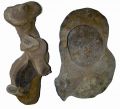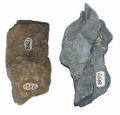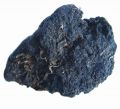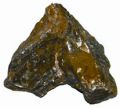Rocks and Minerals
Rocks and Minerals Minerals are naturally formed inorganic substance with a particular chemical composition and a regularly repeating internal structure. They are the constituents of rocks. In more general usage, a mineral is any substance economically valuable for mining (including coal and oil, despite their organic origin). Ice is also a mineral, the crystalline form of water, H2O. Rock is constituent of the earth's crust, composed of mineral particles and/or materials of organic origin consolidated into a hard mass as igneous, sedimentary or metamorphic rocks. Igneous rock is made from magma (molten rock) that has solidified into a hard mass on or beneath the earth surface- example from Bangladesh are granite, pegmatite, granodiorite, tonalite, diorite, dolerite, gabbro; sedimentary rock is formed by the compression of particles deposited by water, wind or ice- example from Bangladesh are sandstone from sand particles, siltstone from silt particles, shale from clay particles, limestone from the remains of sea creatures; metamorphic rock is formed by changes in existing igneous or sedimentary rocks under high pressure or temperature, or chemical action - example from Bangladesh are schist, gneiss, amphibolite.
History The planet earth is a great ball of minerals. Earliest man used stones, clay, colourful or shiny mineral pieces, crystals and native metals as building materials and ornaments. However, the earliest work on minerals is that of Theophrastus (315 BC). The modern aspect of mineralogy began with Georgius Agricola (1546). MH Klaproth began quantitative chemical analysis of minerals around 1800. Max Von Laue's gave the more recent direction of mineralogy that crystals could diffract x-rays in 1912. Shortly after that Bragg, Goldschmidt and Bowen contributed a lot in the field of mineralogy.
In the Indian subcontinent works were mainly concentrated on the exploitation and optimum utilisation of minerals. In India, the formulation of industrial policy resolution in 1956 came as a catalyst for mineral development. Later in 1958 the mineral conservation and development rule was adopted which was ultimately replaced by more comprehensive rules in 1988. With the spread of railways, the demand for metallurgical and chemical products in India has steadily grown. Since 1955 mineral resources like gas, oil, coal, peat, white clay, gravel, hardrock, construction sand, glass sand, beach sand heavy mineral/mineral sand and brick clay have been discovered in Bangladesh. With time and ongoing development activities utilisation of these natural resources is increasing in the country.
Mineral policy of Bangladesh The government owns all the mineral properties of the nation. For managing the nation's natural resources to achieve sustainable development, the government has formulated and promulgated important policies and rules. Some of these are; The Mines and Mineral (Control and Development) Rule 1992, Environment Act 1994, National Energy Policy 1995, Environment Conservation Rules 1997 etc. However, a proposal has been made to amend the Mines and Mineral Rule, 1992 to meet the demands of the present day.
Because of the current global trend the government has committed to the market economy, private entrepreneurs are encouraged and measures have been taken through simplification of procedural obstacles of the new industrial policy (amended in 1992) to attract foreign private investment. Among other mineral resources, natural gas and oil exploration are potential sectors for investment in the country.
Government has adopted policies to attract foreign investment in the mineral sector. Bangladesh is a signatory to the Multilateral Investment Guarantee Agency (MIGA) and to the convention setting up the International Centre for Settlement of Investment Dispute (ICSID).
Some common sample of rocks and minerals
-
Sandstone concretion (Cox’s Bazar and Teknaf)
-
Coquina (St. Martin's Island)
-
Shale (Rangamati)
-
Coral (St. Martin's Island)
-
Peat (Khulna)
-
Petrified Wood (Lalmai, Comilla)
-
Laterite (Sylhet)
-
Fossiliferous limestone (Sylhet)
-
Laterite (Sylhet)
-
Limestone (Sitakunda)
-
Conglomerate (Bandarban)
-
Gneiss with pyrite (Dinajpur Hardrock)
-
Carbonaceous Shale (Sylhet)
-
Granite (Dinajpur)
Regulatory organisations In the mineral sector, the principal government agencies are geological survey of bangladesh (GSB); Bangladesh Oil, Gas and Mineral Corporation (petrobangla); bangladesh petroleum corporation (BPC); and Bureau of Mineral Development (BMD) under the Ministry of Energy and Mineral Resources, and bangladesh atomic energy commission (BAEC) under the Ministry of Science and Technology.
Mineral deposits Gravel, glass sand, construction sand, peat and mineral sand are found in the Holocene sediments, and whiteclay (kaolin) is found in the late Pleistocene sediments in the small hills mainly in the northern part of the country. Whiteclay and glass sand deposits have also been discovered in the northwestern part below the surface. Exploitation of the deposits of limestone, construction sand, gravel, glass sand, white clay and mineral sand is done through small scale quarrying. The subsurface white clay and glass sand deposits have not been mined yet. Developments of subsurface coal and hardrock mines are going on.
Metallic minerals GSB has carried out investigation for mineral deposits and succeeded in locating few potential zones. Relatively high content of metallic minerals like chalcopyrite, bornite, chalcocite, covelline, galena, sphalerite have been found in the core samples from the northwest Bangladesh. Analytical results show presence of silver (25ppm), zinc (88.8ppm), copper (37.25 ppm), and arsenic (8.00 ppm) and trace of gold in the subsurface volcanic rock from the northwestern part of the country. During the current financial year one hole has been drilled in the northwestern part of the country for finding out metallic mineral.
Mineral sand Deposits of mineral sand have been identified in the coastal belt and in the coastal islands of Bangladesh. Different heavy minerals and their reserves (in metric ton) are Zircon (158117), rutile (70274), ilmenite (1025558), leucoxene (96709), kyanite (90745), garnet (222761), magnetite (80599) and monazite (17352). Usually the sands containing monazite and zircon are even finer than the sands containing ilmenite, garnet and rutile. An Australian company has applied for the permission to carry out the feasibility study for exploitation.
Rocks In geology, rock is a naturally occurring solid aggregate of minerals and/or mineraloids.The Earth's outer solid layer, the lithosphere, is made of rock.Rocks are generally classified by mineral and chemical composition, by the texture of the constituent particles and by the processes that formed them. These indicators separate rocks into three types: igneous, sedimentary, and metamorphic. http://en.wikipedia.org/wiki/File:GabbroRockCreek1.jpgIgneous rocks are formed when molten magma cools and are divided into two main categories: plutonic rock and volcanic. Plutonic or intrusive rocks result when magma cools and crystallizes slowly within the Earth's crust (example granite), while volcanic or extrusive rocks result from magma reaching the surface either as lava or fragmental ejecta (examples pumice and basalt). http://en.wikipedia.org/wiki/File:SandstoneUSGOV.jpgSedimentary rocks are formed by deposition of either clastic sediments, organic matter, or chemical precipitates (evaporites), followed by compaction of the particulate matter and cementation during diagenesis. Sedimentary rocks form at or near the Earth's surface. Metamorphic rocks are formed by subjecting any rock type (including previously formed metamorphic rock) to different temperature and pressure conditions than those in which the original rock was formed. http://en.wikipedia.org/wiki/File:Skagit-gneiss-Cascades.jpg
The stable Pre-Cambrian platform of Bangladesh occupies Rajshahi, Bogra, Rangpur and Dinajpur districts and is characterised by limited to moderate thickness of sedimentary rocks above Pre-Cambrian igneous and metamorphic rocks. Occurrence of granitic igneous and schistose-gneissic metamorphic rocks in the shallow subsurface in the Rangpur and Dinajpur areas is due to tectonic stability because of which the Pre-Cambrian basement rock has not subsided too deeply but has remained very near to the surface.
Some fault bounded graben basins occur within the Pre-Cambrian Basement. These basins contain coal bearing rock units of the Permian Period (of 286 to 245 million years before present), the oldest sedimentary rock found in Bangladesh. The geosynclinal basin in the southeast is characterised by the huge thickness (maximum of about 20 km near the basin centre) of clastic sedimentary rocks, mostly sandstone, siltstone and shale together with minor beds of limestone and conglomerates of Tertiary age. It occupies areas of greater Dhaka, Faridpur, Noakhali, Sylhet, Comilla, Chittagong, chittagong hill tracts and the bay of bengal.
Leasing licence Usually a leased area covers about 30 ha of land. The coal and hardrock mines are underground and covers larger areas. Other deposits are exploited through small scale surface quarrying. The number of licences so far issued for developing mines and quarries under the Mines and Mineral Rule, 1968 is shown in the table 1.
Sandstone A sedimentary rock composed of sand-size particles (more than 1/16 mm and less than 2 mm) or fragments. Sandstone is the second most abundant rock after shale. It forms from sands deposited in river, in delta, in shallow seas, in deep seas, in desert or other sedimentary environments. It is one of the most important rocks to form petroleum reservoirs. In fact, almost half of the petroleum reservoirs throughout the world are composed of sandstone. All the gas reservoirs of Bangladesh gasfields are formed of sandstone. These are good to excellent quality reservoirs because of the high porosity and permeability of the rock. Apart from forming the gas reservoirs, sandstone is a very common rock in the geologic formations of Bangladesh. The younger geologic units known as Dupitila Formation and Tipam Formation are predominantly composed of sandstone, and formed the low hills in the eastern hilly areas of Bangladesh. The underlying Surma Group unit is composed of subequal sandstone (gas reservoirs) and shale interbeds. Sandstone is often used as building material as blocks in the construction of large buildings.
Siltstone An indurated silt having the texture and composition of shale but lacking its fine lamination or fissility. The detrital particle is finer than fine sand and coarser than clay, generally in the diameter range of 1/16 to 1/256 mm. The Surma Group and the Holocene sediments of Bangladesh contain substantial amounts of siltstone.
Clay (shale) Argillaceous rock composed of fine grained (finer than 3 B5m) clastic sediments; consists of minute, flaky crystals of minerals produced by chemical weathering of crystalline rocks. In Bangladesh Permian and Tertiary shales include quartz, illite, kaolinite, chlorite and illite/smectite mixed layer clay as the major component, feldspar as the minor component and calcite, dolomite and siderite in trace amounts. In Permian clays illite-smectite mixed layer clay mineral does not occur. However, in Tertiary clays randomly interstratified illite/smectite mixed layer clay mineral shows progressive diagenetic illitization with decreasing expandability of illite/smectite clays estimated by quantitative method and also by the decreasing 17A glycolated peak intensity with increasing stratigraphical and burial depths. Significant volume of smectite diagenesis derived water should have been available at this level to migrate from smectite interlayers to the pore water system. It is suggested that this water has contributed to the generation of overpressures, as well as facilitated the primary migration of hydrocarbons from mudstones encountered in the subsurface of Bengal foredeep and fold belt areas. [AKM Khorshed Alam and Sifatul Quader Chowdhury]
See also mineral resources.
See map in mineral resources.














